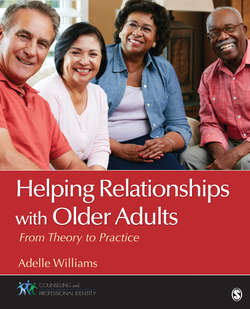Читать книгу Helping Relationships With Older Adults - Adelle M. Williams - Страница 27
На сайте Литреса книга снята с продажи.
Vision
ОглавлениеA reduction in vision can have a negative psychological impact on many aspects of functioning in older adults. Older adults may not be able to enjoy leisure activities such as reading, watching television, playing chess/checkers, finishing crossword puzzles, and a host of other activities. A loss of vision may impede social activities and physical activities, which will eventually negatively impact their emotional and physical health. Loss of vision will impact their ability to remain independent in their homes and also negatively impact their ability to drive. Older adults may suffer unnecessary falls due to their decreased vision. Self-esteem will be adversely affected, interaction with significant others will be challenging and their overall quality of life is diminished. Counselors can help older adults adjust to their vision loss. They can support them with resolving any issues resulting from the visual impairments. Counselors can also encourage or make referrals for optical devices (e.g., eye glasses, larger numbers on their phones). Counselors can provide strategies to live independently with redesigning their environment, and they can also monitor their compliance with any treatment regimes. Loss of independence will be a concern for many older adults who are visually impaired, and counselors are positioned to facilitate the relocation to another environment (if necessary) and to offer resources as alternatives for loss of ability to drive. Counselors will provide support, encouragement, coping strategies, referrals, and resources to make the transition easier for older adults, while maintaining a focus on strengths and capabilities versus disabilities with older clients.
Vision is affected in various ways due to aging. Changes occur in the components of the eye itself and in central processing in the brain. These changes affect reading, balance, and driving, but compensatory glasses and behavior can maintain safety. As the eyes age, it is normal for older adults to have a reduced visual field. Pure aging makes clear that no disease, environmental, lifestyle, or behavioral risk factor plays a role in the change. It includes a decline in accommodation, which is the increase in optical power by the eye in order to maintain a clear image (focus) as objects are moved closer (e.g., presbyopia or farsightedness). Low-contrast acuity refers to the sharpness or keenness of vision. Glare tolerance declines, as does adaptation (adjustment to environmental conditions) and color discrimination. Also, there is a decreased attentional visual field that describes a person’s ability to divide attention and extract visual information from the visual field within a glance. The common eye diseases in old age (e.g., glaucoma, macular degeneration, cataracts, diabetic retinopathy) are superimposed upon these pure aging changes (Besdine & Wu, 2008).
Older individuals may begin to have difficulties with contrast sensitivity, in which the difference between an object and its background is reduced. This reduction in sensitivity is gradual because of progressive eye problems that can lead to scarring or clouding of the cornea, which decreases vision. Decreased contrast sensitivity also diminishes an elderly person’s ability to perceive depth. Reduced depth perception makes steps or street curves difficult to manage. Additionally, seeing at night can become difficult. A person with early nuclear sclerosis (cloudiness of the eye lens) may complain of glare especially during night driving, due to light scattering, which is light directed in many different directions. At the same time, older people need more lighting in their surroundings than a younger person. Beginning in the early mid-40s, most adults start to experience problems with their ability to see clearly at close distances, especially for reading and computer tasks.
A reduction in number of cones at the fovea causes generalized reduction in color vision. Fovea is the central focal point on the retina (lines the back of the eye) around which cones cluster. Cones are photoreceptors located near the center of the retina that are responsible for your ability to see during the day, in color, and in detail. For people of all ages, it is harder to distinguish blues and greens than it is to differentiate reds and yellows. This becomes even more pronounced with age. Using more warm contrasting colors (e.g., yellow, orange, and red) in the home can improve the ability to determine where things are and make it easier to perform activities of daily living. Many older people find that keeping a red light on in darkened rooms (such as the hallway or bathroom) makes it easier to see than a regular night light (white/yellow in color) (Salvi, Currie, &Akhtar, 2005). Another common visual change in older adults is the increase of floaters or tiny black specks moving across their field of vision. These specks are bits of normal fluid in the eye that have solidified. Floaters do not significantly interfere with vision and are not a cause for concern unless they suddenly increase in number. Additionally, the eyes tend to become dry. This change occurs due to a decrease in the number of cells that produce fluids to lubricate and a decrease in tear production (Porter, 2009). Vision loss has profound effects on the quality of life of older adults, as does the loss of hearing.
